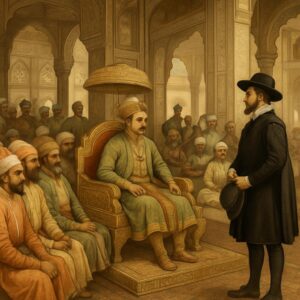French Merchant Reveals Astonishing Details of Daily Life in 17th Century Mughal Court
In a remarkable series of travelogues that provide unprecedented insights into the splendor and complexity of the Mughal Empire at its zenith, French gem merchant Jean-Baptiste Tavernier has documented his extensive journeys throughout India between 1638 and 1668.
## Abundance Amid Ordinary Life
Contrary to European perceptions of distant lands as places of scarcity, Tavernier reports extraordinary abundance throughout the Mughal domains. “Even in the smallest villages, rice, flour, butter, milk, beans and other vegetables, sugar and sweetmeats, dry and liquid, can be procured in abundance,” he writes, suggesting a level of food security and distribution efficiency that rivals or exceeds contemporary European standards.
This observation challenges prevailing Western assumptions about living conditions in Asia and reveals the sophisticated agricultural and commercial networks that sustained the empire’s prosperity across its vast territories.
## Imperial Spectacle Beyond European Imagination
Tavernier’s accounts of Mughal court ceremonies describe displays of wealth and pageantry that dwarf anything seen in European royal courts. The French merchant details Shah Jahan’s routine mosque visits, which featured processions of 80 elaborately decorated elephants—a display of imperial grandeur that served both religious and political purposes.
Even more impressive were the imperial hunting expeditions under Aurangzeb, which Tavernier describes as military operations in scale: “The Emperor’s fortnightly hunts employ thousands of men as beaters alone, creating a moving wall of humanity that drives game toward the royal party,” he notes, revealing how even leisure activities served to demonstrate imperial power and organizational capacity.
## The Legendary Peacock Throne: A Wonder Quantified
While rumors of Mughal wealth had reached Europe before, Tavernier provides the first detailed inventory of the empire’s most famous treasure—the Peacock Throne. With the precision of a professional gemologist, he counts “108 rubies, none below 100 carats” and “160 emeralds, none below 30 carats,” along with countless diamonds and pearls adorning this masterpiece of royal craftsmanship.
His description of the throne’s crowning glory—a jeweled peacock “consisting all of sapphires…with a great ruby upon its breast, at which hangs a pearl that weighs fifty carats”—offers concrete evidence of wealth that European monarchs could scarcely imagine, much less match.
## Witnessing History: A Dynasty in Transition
Beyond material observations, Tavernier provides eyewitness accounts of pivotal historical moments, including the succession struggle between Shah Jahan and Aurangzeb. His description of the elderly Shah Jahan hurling bitter curses at his son from imprisonment reveals the personal dimension of political conflict that official chronicles often omit.
Even more poignant is Tavernier’s account of Aurangzeb’s reaction upon receiving his brother Dara Shikoh’s severed head—despite ordering the execution himself, the emperor “fell to his knees weeping” and commanded that his rival’s remains receive proper burial in Humayun’s Tomb. This glimpse of private emotion from a ruler typically portrayed as coldly calculating adds nuance to historical understanding of this controversial figure.
## Early Signs of European Commercial Ambitions
With a merchant’s eye for shifting power dynamics, Tavernier notes the presence of Dutch and British East India Company representatives at Aurangzeb’s coronation. “These European traders cultivate imperial favor not through military might but through commercial necessity,” he observes, unwittingly documenting the early stages of what would eventually transform into colonial domination.
His observation that these company officials “needed to ensure warm ties with the Mughal court in order to trade” captures a moment when European powers still approached Asian rulers as equals or superiors—a relationship that would dramatically reverse in the following century.
## The Diamond Trade: Global Luxury’s Source
As a gem merchant, Tavernier provides uniquely informed insights into the diamond mines of Golconda, then the world’s sole source of these precious stones. His firsthand visits to the mines document not only the extraction process but the complex trading networks that connected Indian gemstones to global markets.
The merchant’s acquisition of a rare 112-carat blue diamond (later known as the Tavernier Blue and eventually recut to become the famous Hope Diamond) represents a tangible connection between Mughal India’s natural resources and the European luxury market that coveted them.
## A Valuable Historical Window
Tavernier’s accounts stand as essential primary sources for understanding Mughal India during its golden age. Unlike official court chroniclers or religious missionaries, his commercial perspective captures aspects of daily life, economic conditions, and political realities that other observers overlooked or deliberately omitted.
His detailed observations of everything from village markets to imperial ceremonies provide a comprehensive picture of a sophisticated civilization at its peak—one whose wealth, cultural refinement, and administrative complexity rivaled or surpassed anything in contemporary Europe.
*This historical news item is based on Jean-Baptiste Tavernier’s travelogues documenting his five visits to India between 1638 and 1668.*

